Telehealth Project: Information Report, Stakeholder Map & Analysis
VerifiedAdded on 2023/04/21
|10
|2101
|282
Project
AI Summary
This project information report details the After-Hours Urgent Care Telehealth project, focusing on improving healthcare access in rural areas through telehealth solutions. It includes a stakeholder map identifying key stakeholders such as hospital staff, management, project team members, government entities, and external contractors, outlining their roles and responsibilities in the project's success. The report also presents a questionnaire designed to gather user feedback on system functionalities like authentication, database integration, and user-friendliness, aiming to refine the telehealth system's design and implementation. Additionally, use case diagrams and descriptions are provided, illustrating various system interactions such as treatment and care unit operations, service development, and video conferencing functionalities, ensuring seamless communication and efficient healthcare delivery. Desklib provides a platform for students to access similar solved assignments and past papers.
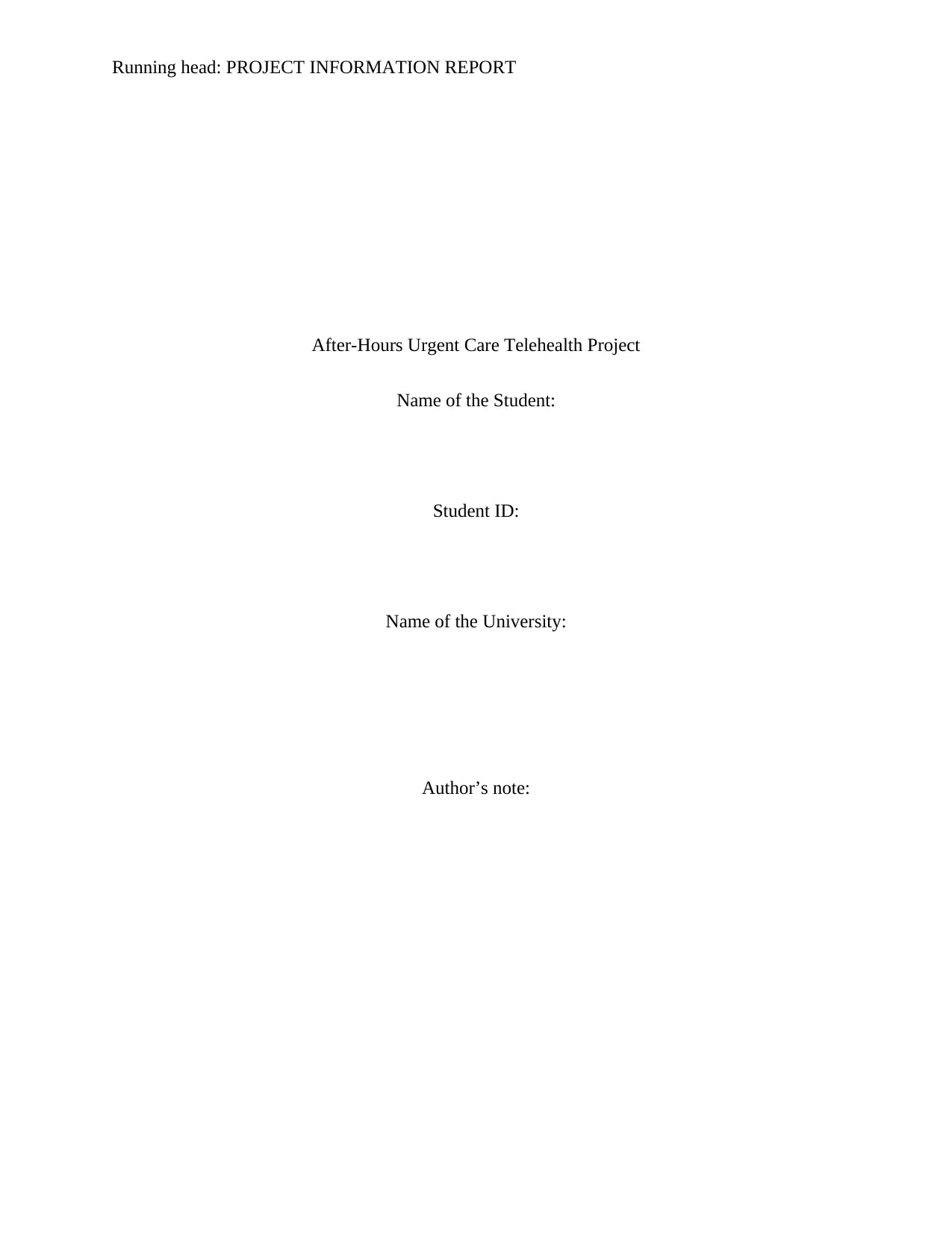
Running head: PROJECT INFORMATION REPORT
After-Hours Urgent Care Telehealth Project
Name of the Student:
Student ID:
Name of the University:
Author’s note:
After-Hours Urgent Care Telehealth Project
Name of the Student:
Student ID:
Name of the University:
Author’s note:
Paraphrase This Document
Need a fresh take? Get an instant paraphrase of this document with our AI Paraphraser
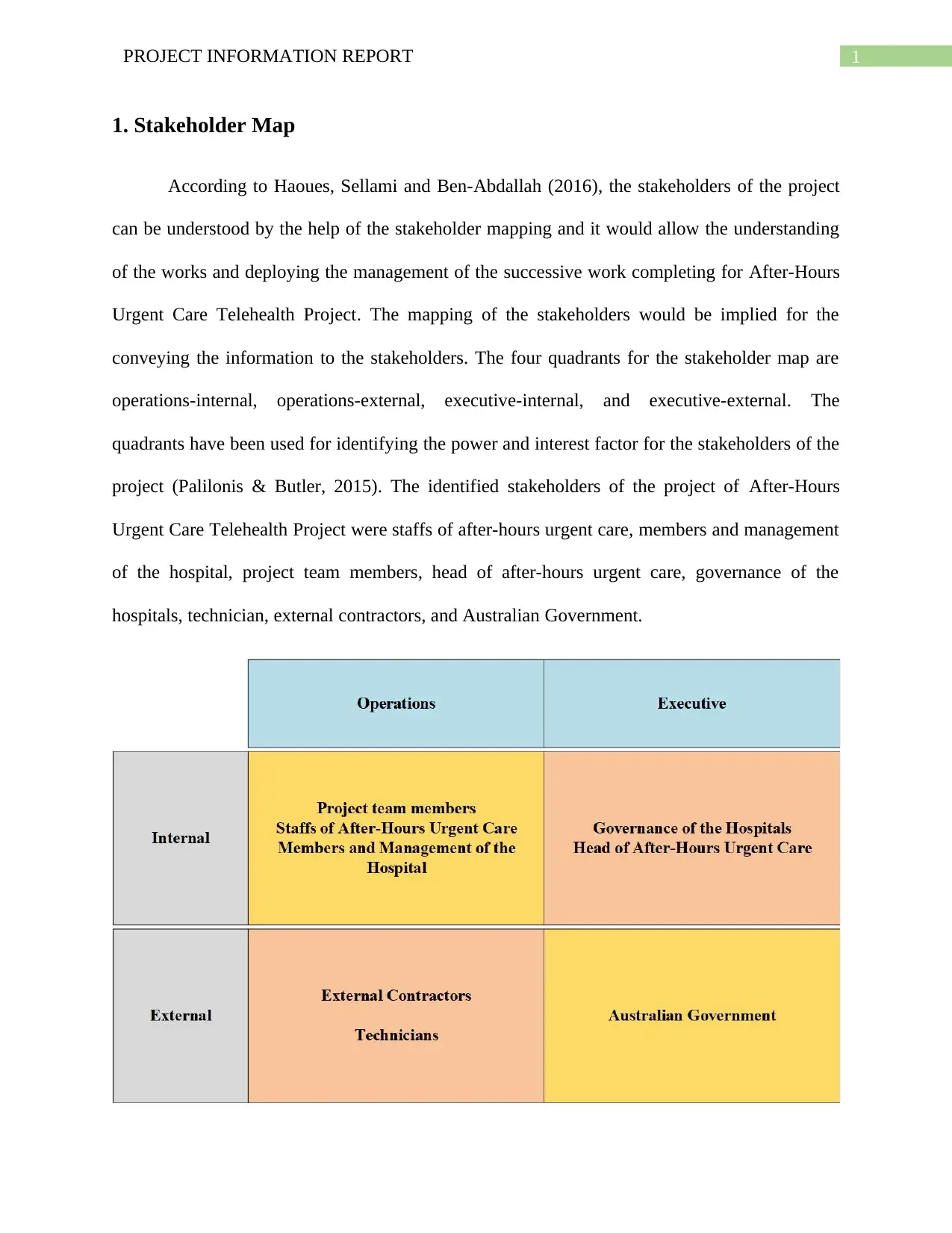
1PROJECT INFORMATION REPORT
1. Stakeholder Map
According to Haoues, Sellami and Ben-Abdallah (2016), the stakeholders of the project
can be understood by the help of the stakeholder mapping and it would allow the understanding
of the works and deploying the management of the successive work completing for After-Hours
Urgent Care Telehealth Project. The mapping of the stakeholders would be implied for the
conveying the information to the stakeholders. The four quadrants for the stakeholder map are
operations-internal, operations-external, executive-internal, and executive-external. The
quadrants have been used for identifying the power and interest factor for the stakeholders of the
project (Palilonis & Butler, 2015). The identified stakeholders of the project of After-Hours
Urgent Care Telehealth Project were staffs of after-hours urgent care, members and management
of the hospital, project team members, head of after-hours urgent care, governance of the
hospitals, technician, external contractors, and Australian Government.
1. Stakeholder Map
According to Haoues, Sellami and Ben-Abdallah (2016), the stakeholders of the project
can be understood by the help of the stakeholder mapping and it would allow the understanding
of the works and deploying the management of the successive work completing for After-Hours
Urgent Care Telehealth Project. The mapping of the stakeholders would be implied for the
conveying the information to the stakeholders. The four quadrants for the stakeholder map are
operations-internal, operations-external, executive-internal, and executive-external. The
quadrants have been used for identifying the power and interest factor for the stakeholders of the
project (Palilonis & Butler, 2015). The identified stakeholders of the project of After-Hours
Urgent Care Telehealth Project were staffs of after-hours urgent care, members and management
of the hospital, project team members, head of after-hours urgent care, governance of the
hospitals, technician, external contractors, and Australian Government.
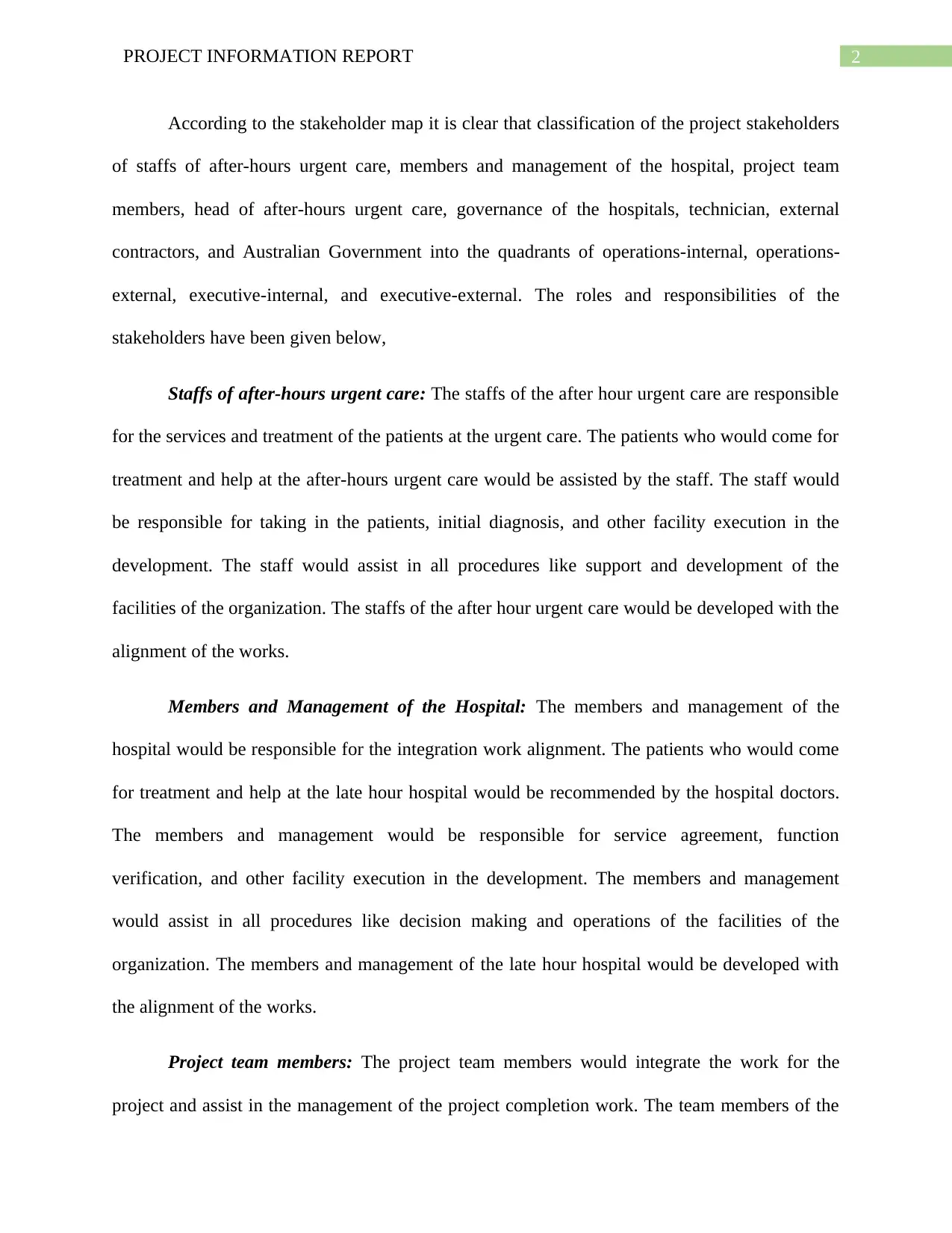
2PROJECT INFORMATION REPORT
According to the stakeholder map it is clear that classification of the project stakeholders
of staffs of after-hours urgent care, members and management of the hospital, project team
members, head of after-hours urgent care, governance of the hospitals, technician, external
contractors, and Australian Government into the quadrants of operations-internal, operations-
external, executive-internal, and executive-external. The roles and responsibilities of the
stakeholders have been given below,
Staffs of after-hours urgent care: The staffs of the after hour urgent care are responsible
for the services and treatment of the patients at the urgent care. The patients who would come for
treatment and help at the after-hours urgent care would be assisted by the staff. The staff would
be responsible for taking in the patients, initial diagnosis, and other facility execution in the
development. The staff would assist in all procedures like support and development of the
facilities of the organization. The staffs of the after hour urgent care would be developed with the
alignment of the works.
Members and Management of the Hospital: The members and management of the
hospital would be responsible for the integration work alignment. The patients who would come
for treatment and help at the late hour hospital would be recommended by the hospital doctors.
The members and management would be responsible for service agreement, function
verification, and other facility execution in the development. The members and management
would assist in all procedures like decision making and operations of the facilities of the
organization. The members and management of the late hour hospital would be developed with
the alignment of the works.
Project team members: The project team members would integrate the work for the
project and assist in the management of the project completion work. The team members of the
According to the stakeholder map it is clear that classification of the project stakeholders
of staffs of after-hours urgent care, members and management of the hospital, project team
members, head of after-hours urgent care, governance of the hospitals, technician, external
contractors, and Australian Government into the quadrants of operations-internal, operations-
external, executive-internal, and executive-external. The roles and responsibilities of the
stakeholders have been given below,
Staffs of after-hours urgent care: The staffs of the after hour urgent care are responsible
for the services and treatment of the patients at the urgent care. The patients who would come for
treatment and help at the after-hours urgent care would be assisted by the staff. The staff would
be responsible for taking in the patients, initial diagnosis, and other facility execution in the
development. The staff would assist in all procedures like support and development of the
facilities of the organization. The staffs of the after hour urgent care would be developed with the
alignment of the works.
Members and Management of the Hospital: The members and management of the
hospital would be responsible for the integration work alignment. The patients who would come
for treatment and help at the late hour hospital would be recommended by the hospital doctors.
The members and management would be responsible for service agreement, function
verification, and other facility execution in the development. The members and management
would assist in all procedures like decision making and operations of the facilities of the
organization. The members and management of the late hour hospital would be developed with
the alignment of the works.
Project team members: The project team members would integrate the work for the
project and assist in the management of the project completion work. The team members of the
⊘ This is a preview!⊘
Do you want full access?
Subscribe today to unlock all pages.

Trusted by 1+ million students worldwide
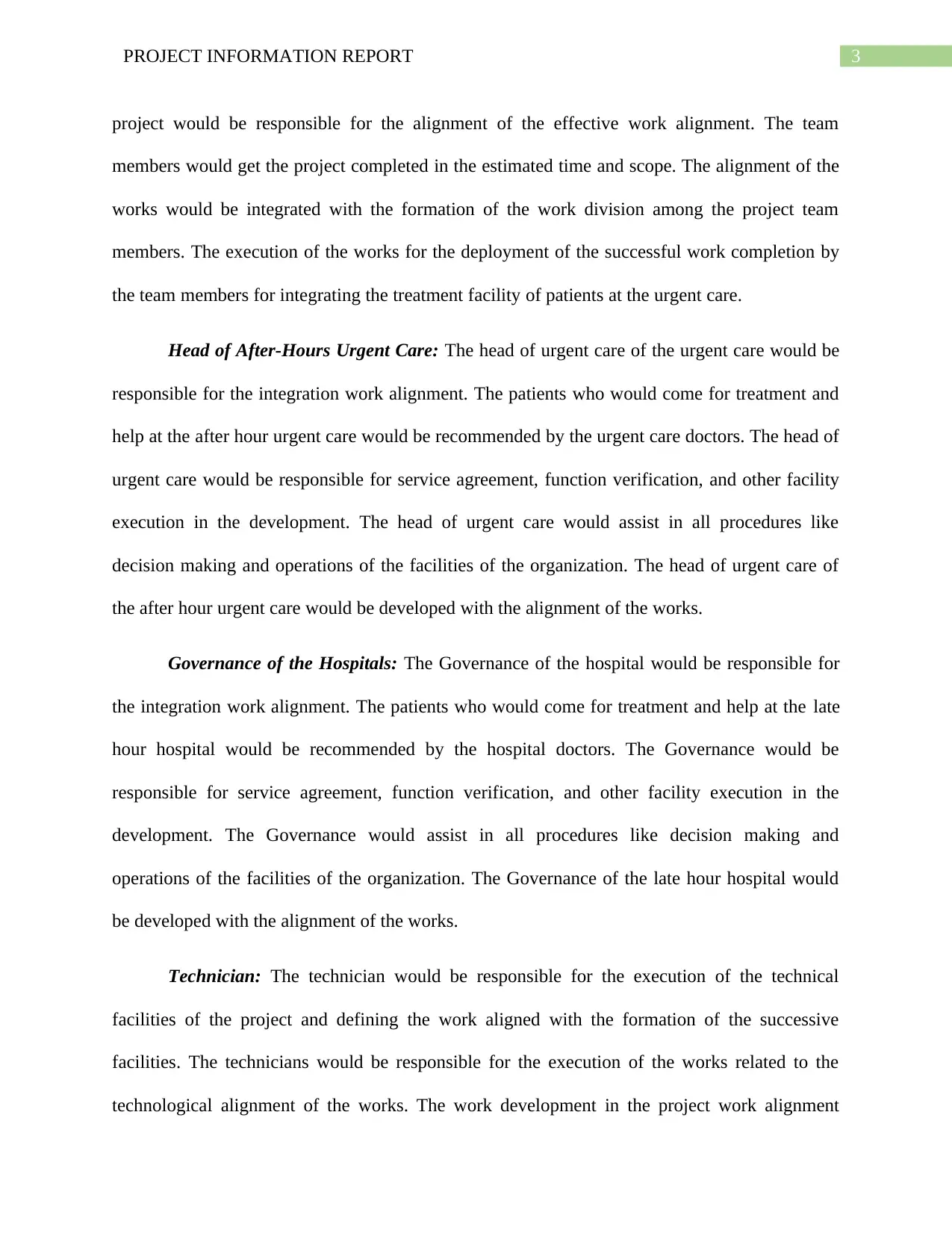
3PROJECT INFORMATION REPORT
project would be responsible for the alignment of the effective work alignment. The team
members would get the project completed in the estimated time and scope. The alignment of the
works would be integrated with the formation of the work division among the project team
members. The execution of the works for the deployment of the successful work completion by
the team members for integrating the treatment facility of patients at the urgent care.
Head of After-Hours Urgent Care: The head of urgent care of the urgent care would be
responsible for the integration work alignment. The patients who would come for treatment and
help at the after hour urgent care would be recommended by the urgent care doctors. The head of
urgent care would be responsible for service agreement, function verification, and other facility
execution in the development. The head of urgent care would assist in all procedures like
decision making and operations of the facilities of the organization. The head of urgent care of
the after hour urgent care would be developed with the alignment of the works.
Governance of the Hospitals: The Governance of the hospital would be responsible for
the integration work alignment. The patients who would come for treatment and help at the late
hour hospital would be recommended by the hospital doctors. The Governance would be
responsible for service agreement, function verification, and other facility execution in the
development. The Governance would assist in all procedures like decision making and
operations of the facilities of the organization. The Governance of the late hour hospital would
be developed with the alignment of the works.
Technician: The technician would be responsible for the execution of the technical
facilities of the project and defining the work aligned with the formation of the successive
facilities. The technicians would be responsible for the execution of the works related to the
technological alignment of the works. The work development in the project work alignment
project would be responsible for the alignment of the effective work alignment. The team
members would get the project completed in the estimated time and scope. The alignment of the
works would be integrated with the formation of the work division among the project team
members. The execution of the works for the deployment of the successful work completion by
the team members for integrating the treatment facility of patients at the urgent care.
Head of After-Hours Urgent Care: The head of urgent care of the urgent care would be
responsible for the integration work alignment. The patients who would come for treatment and
help at the after hour urgent care would be recommended by the urgent care doctors. The head of
urgent care would be responsible for service agreement, function verification, and other facility
execution in the development. The head of urgent care would assist in all procedures like
decision making and operations of the facilities of the organization. The head of urgent care of
the after hour urgent care would be developed with the alignment of the works.
Governance of the Hospitals: The Governance of the hospital would be responsible for
the integration work alignment. The patients who would come for treatment and help at the late
hour hospital would be recommended by the hospital doctors. The Governance would be
responsible for service agreement, function verification, and other facility execution in the
development. The Governance would assist in all procedures like decision making and
operations of the facilities of the organization. The Governance of the late hour hospital would
be developed with the alignment of the works.
Technician: The technician would be responsible for the execution of the technical
facilities of the project and defining the work aligned with the formation of the successive
facilities. The technicians would be responsible for the execution of the works related to the
technological alignment of the works. The work development in the project work alignment
Paraphrase This Document
Need a fresh take? Get an instant paraphrase of this document with our AI Paraphraser
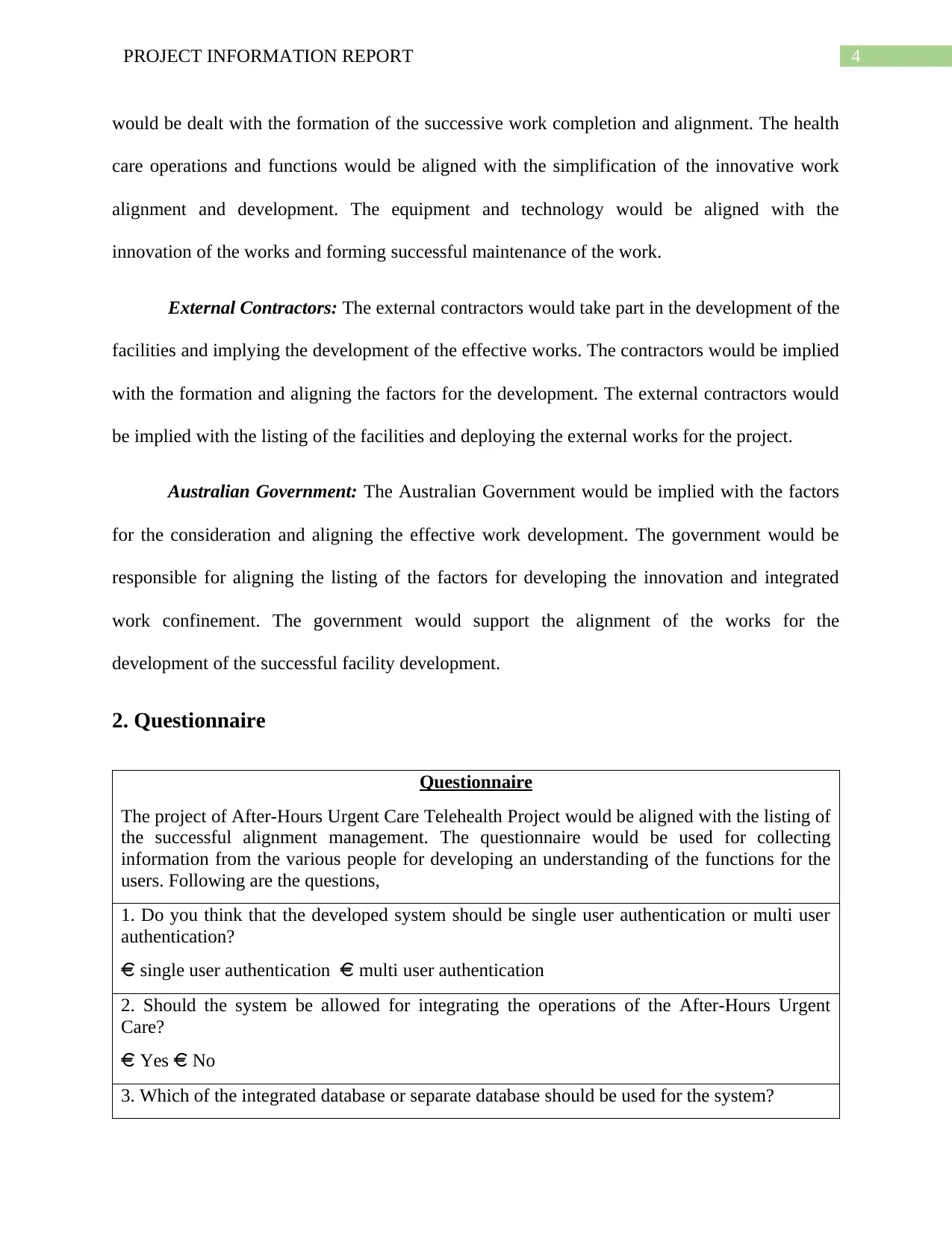
4PROJECT INFORMATION REPORT
would be dealt with the formation of the successive work completion and alignment. The health
care operations and functions would be aligned with the simplification of the innovative work
alignment and development. The equipment and technology would be aligned with the
innovation of the works and forming successful maintenance of the work.
External Contractors: The external contractors would take part in the development of the
facilities and implying the development of the effective works. The contractors would be implied
with the formation and aligning the factors for the development. The external contractors would
be implied with the listing of the facilities and deploying the external works for the project.
Australian Government: The Australian Government would be implied with the factors
for the consideration and aligning the effective work development. The government would be
responsible for aligning the listing of the factors for developing the innovation and integrated
work confinement. The government would support the alignment of the works for the
development of the successful facility development.
2. Questionnaire
Questionnaire
The project of After-Hours Urgent Care Telehealth Project would be aligned with the listing of
the successful alignment management. The questionnaire would be used for collecting
information from the various people for developing an understanding of the functions for the
users. Following are the questions,
1. Do you think that the developed system should be single user authentication or multi user
authentication?
single user authentication multi user authentication
2. Should the system be allowed for integrating the operations of the After-Hours Urgent
Care?
Yes No
3. Which of the integrated database or separate database should be used for the system?
would be dealt with the formation of the successive work completion and alignment. The health
care operations and functions would be aligned with the simplification of the innovative work
alignment and development. The equipment and technology would be aligned with the
innovation of the works and forming successful maintenance of the work.
External Contractors: The external contractors would take part in the development of the
facilities and implying the development of the effective works. The contractors would be implied
with the formation and aligning the factors for the development. The external contractors would
be implied with the listing of the facilities and deploying the external works for the project.
Australian Government: The Australian Government would be implied with the factors
for the consideration and aligning the effective work development. The government would be
responsible for aligning the listing of the factors for developing the innovation and integrated
work confinement. The government would support the alignment of the works for the
development of the successful facility development.
2. Questionnaire
Questionnaire
The project of After-Hours Urgent Care Telehealth Project would be aligned with the listing of
the successful alignment management. The questionnaire would be used for collecting
information from the various people for developing an understanding of the functions for the
users. Following are the questions,
1. Do you think that the developed system should be single user authentication or multi user
authentication?
single user authentication multi user authentication
2. Should the system be allowed for integrating the operations of the After-Hours Urgent
Care?
Yes No
3. Which of the integrated database or separate database should be used for the system?
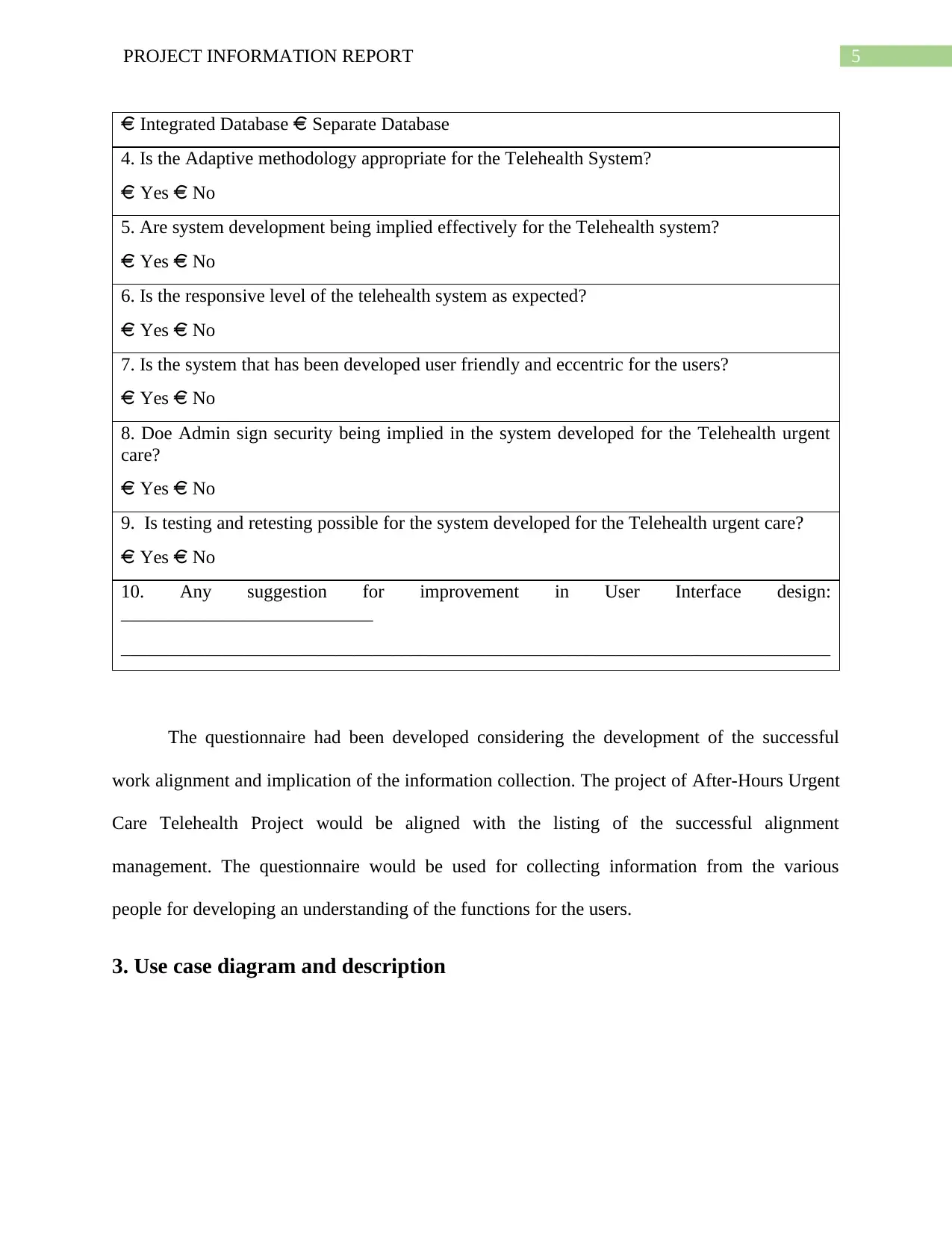
5PROJECT INFORMATION REPORT
Integrated Database Separate Database
4. Is the Adaptive methodology appropriate for the Telehealth System?
Yes No
5. Are system development being implied effectively for the Telehealth system?
Yes No
6. Is the responsive level of the telehealth system as expected?
Yes No
7. Is the system that has been developed user friendly and eccentric for the users?
Yes No
8. Doe Admin sign security being implied in the system developed for the Telehealth urgent
care?
Yes No
9. Is testing and retesting possible for the system developed for the Telehealth urgent care?
Yes No
10. Any suggestion for improvement in User Interface design:
___________________________
____________________________________________________________________________
The questionnaire had been developed considering the development of the successful
work alignment and implication of the information collection. The project of After-Hours Urgent
Care Telehealth Project would be aligned with the listing of the successful alignment
management. The questionnaire would be used for collecting information from the various
people for developing an understanding of the functions for the users.
3. Use case diagram and description
Integrated Database Separate Database
4. Is the Adaptive methodology appropriate for the Telehealth System?
Yes No
5. Are system development being implied effectively for the Telehealth system?
Yes No
6. Is the responsive level of the telehealth system as expected?
Yes No
7. Is the system that has been developed user friendly and eccentric for the users?
Yes No
8. Doe Admin sign security being implied in the system developed for the Telehealth urgent
care?
Yes No
9. Is testing and retesting possible for the system developed for the Telehealth urgent care?
Yes No
10. Any suggestion for improvement in User Interface design:
___________________________
____________________________________________________________________________
The questionnaire had been developed considering the development of the successful
work alignment and implication of the information collection. The project of After-Hours Urgent
Care Telehealth Project would be aligned with the listing of the successful alignment
management. The questionnaire would be used for collecting information from the various
people for developing an understanding of the functions for the users.
3. Use case diagram and description
⊘ This is a preview!⊘
Do you want full access?
Subscribe today to unlock all pages.

Trusted by 1+ million students worldwide
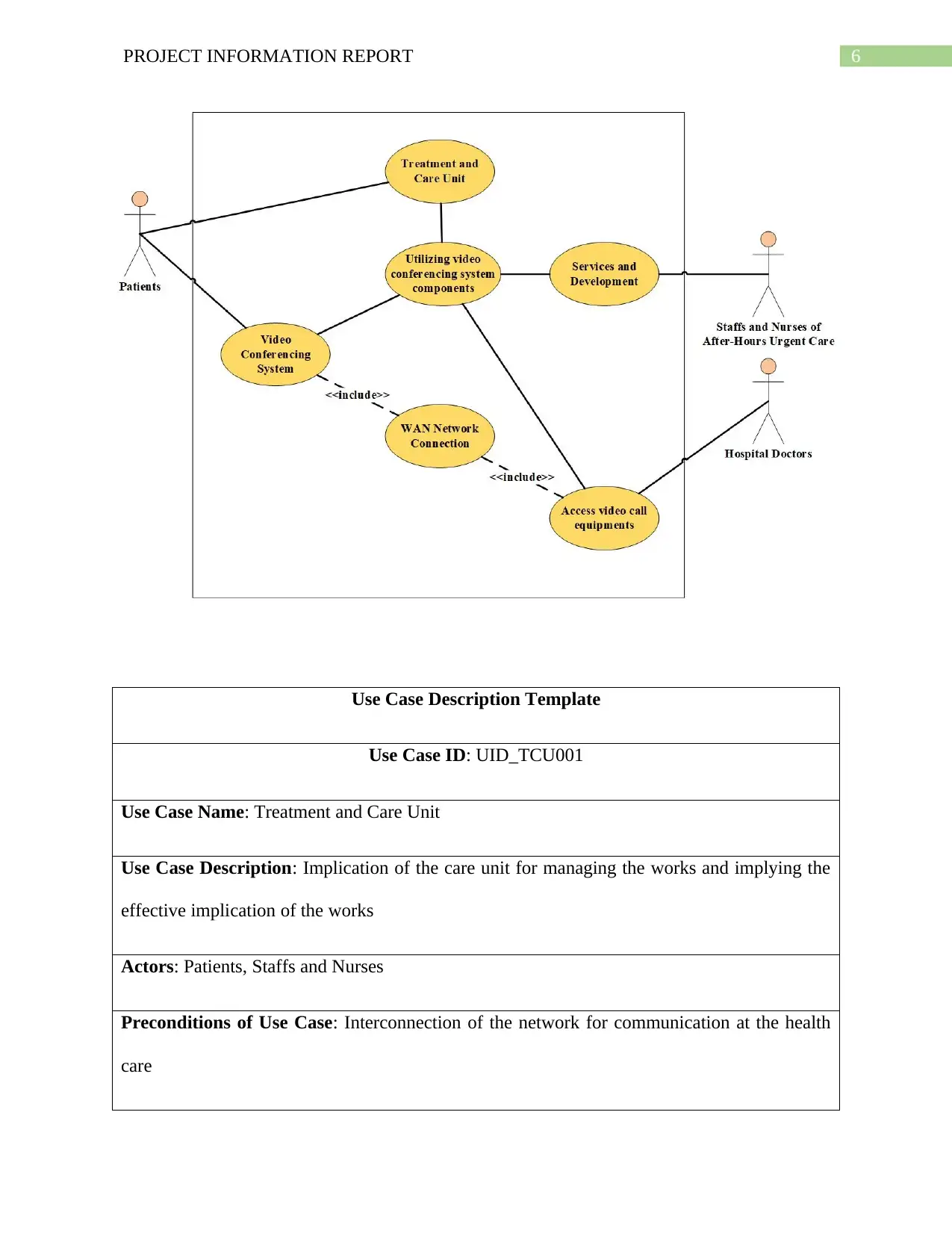
6PROJECT INFORMATION REPORT
Use Case Description Template
Use Case ID: UID_TCU001
Use Case Name: Treatment and Care Unit
Use Case Description: Implication of the care unit for managing the works and implying the
effective implication of the works
Actors: Patients, Staffs and Nurses
Preconditions of Use Case: Interconnection of the network for communication at the health
care
Use Case Description Template
Use Case ID: UID_TCU001
Use Case Name: Treatment and Care Unit
Use Case Description: Implication of the care unit for managing the works and implying the
effective implication of the works
Actors: Patients, Staffs and Nurses
Preconditions of Use Case: Interconnection of the network for communication at the health
care
Paraphrase This Document
Need a fresh take? Get an instant paraphrase of this document with our AI Paraphraser
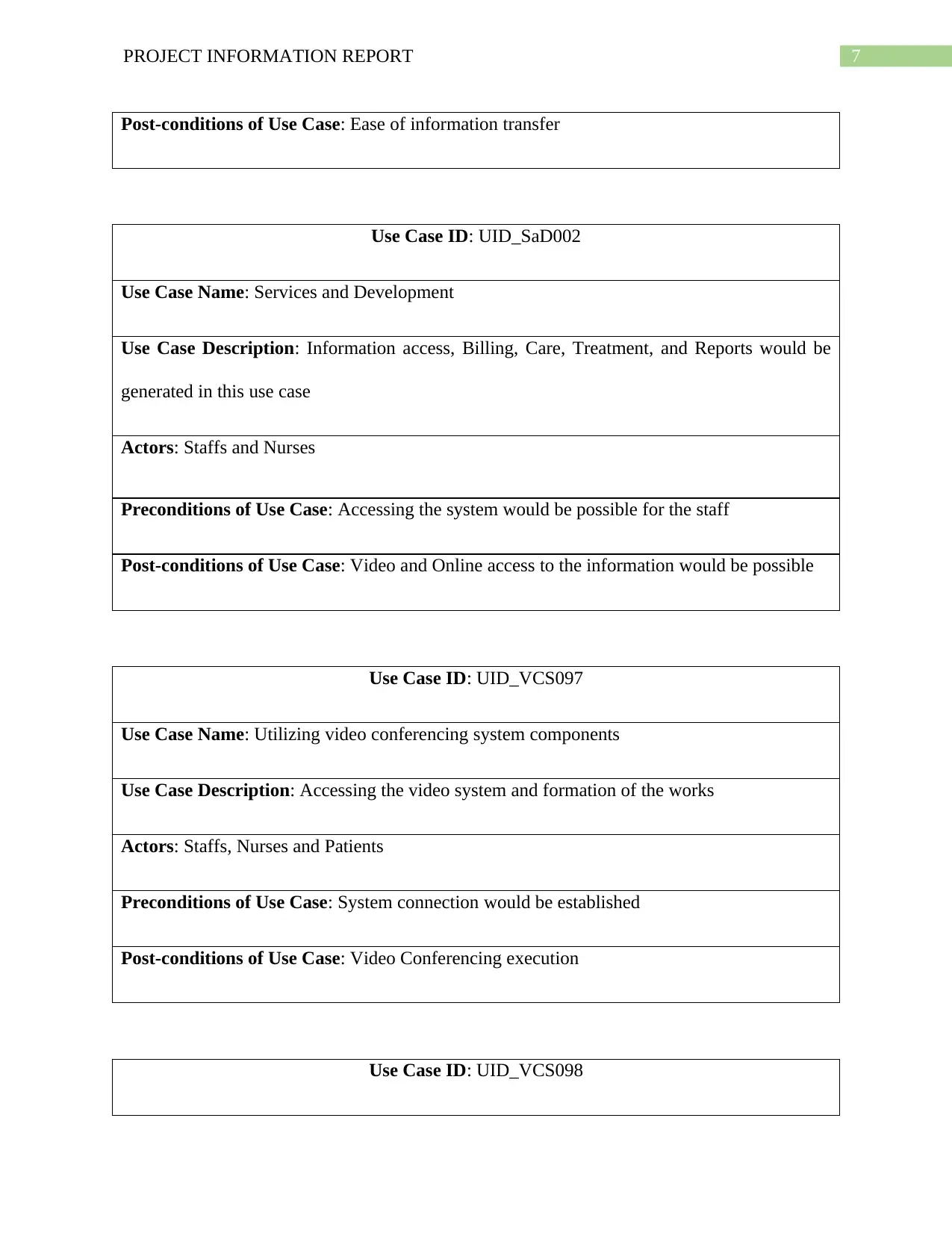
7PROJECT INFORMATION REPORT
Post-conditions of Use Case: Ease of information transfer
Use Case ID: UID_SaD002
Use Case Name: Services and Development
Use Case Description: Information access, Billing, Care, Treatment, and Reports would be
generated in this use case
Actors: Staffs and Nurses
Preconditions of Use Case: Accessing the system would be possible for the staff
Post-conditions of Use Case: Video and Online access to the information would be possible
Use Case ID: UID_VCS097
Use Case Name: Utilizing video conferencing system components
Use Case Description: Accessing the video system and formation of the works
Actors: Staffs, Nurses and Patients
Preconditions of Use Case: System connection would be established
Post-conditions of Use Case: Video Conferencing execution
Use Case ID: UID_VCS098
Post-conditions of Use Case: Ease of information transfer
Use Case ID: UID_SaD002
Use Case Name: Services and Development
Use Case Description: Information access, Billing, Care, Treatment, and Reports would be
generated in this use case
Actors: Staffs and Nurses
Preconditions of Use Case: Accessing the system would be possible for the staff
Post-conditions of Use Case: Video and Online access to the information would be possible
Use Case ID: UID_VCS097
Use Case Name: Utilizing video conferencing system components
Use Case Description: Accessing the video system and formation of the works
Actors: Staffs, Nurses and Patients
Preconditions of Use Case: System connection would be established
Post-conditions of Use Case: Video Conferencing execution
Use Case ID: UID_VCS098
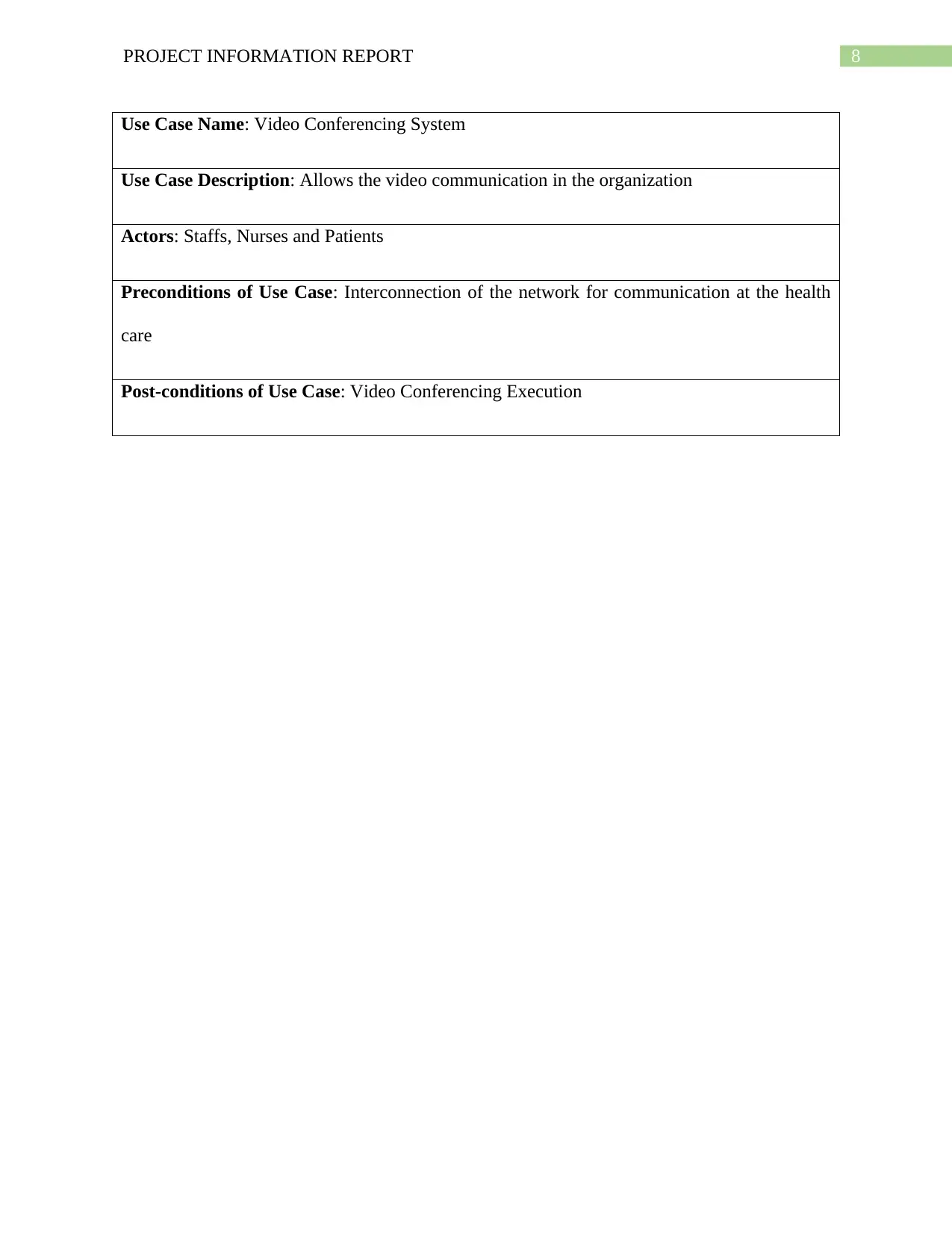
8PROJECT INFORMATION REPORT
Use Case Name: Video Conferencing System
Use Case Description: Allows the video communication in the organization
Actors: Staffs, Nurses and Patients
Preconditions of Use Case: Interconnection of the network for communication at the health
care
Post-conditions of Use Case: Video Conferencing Execution
Use Case Name: Video Conferencing System
Use Case Description: Allows the video communication in the organization
Actors: Staffs, Nurses and Patients
Preconditions of Use Case: Interconnection of the network for communication at the health
care
Post-conditions of Use Case: Video Conferencing Execution
⊘ This is a preview!⊘
Do you want full access?
Subscribe today to unlock all pages.

Trusted by 1+ million students worldwide
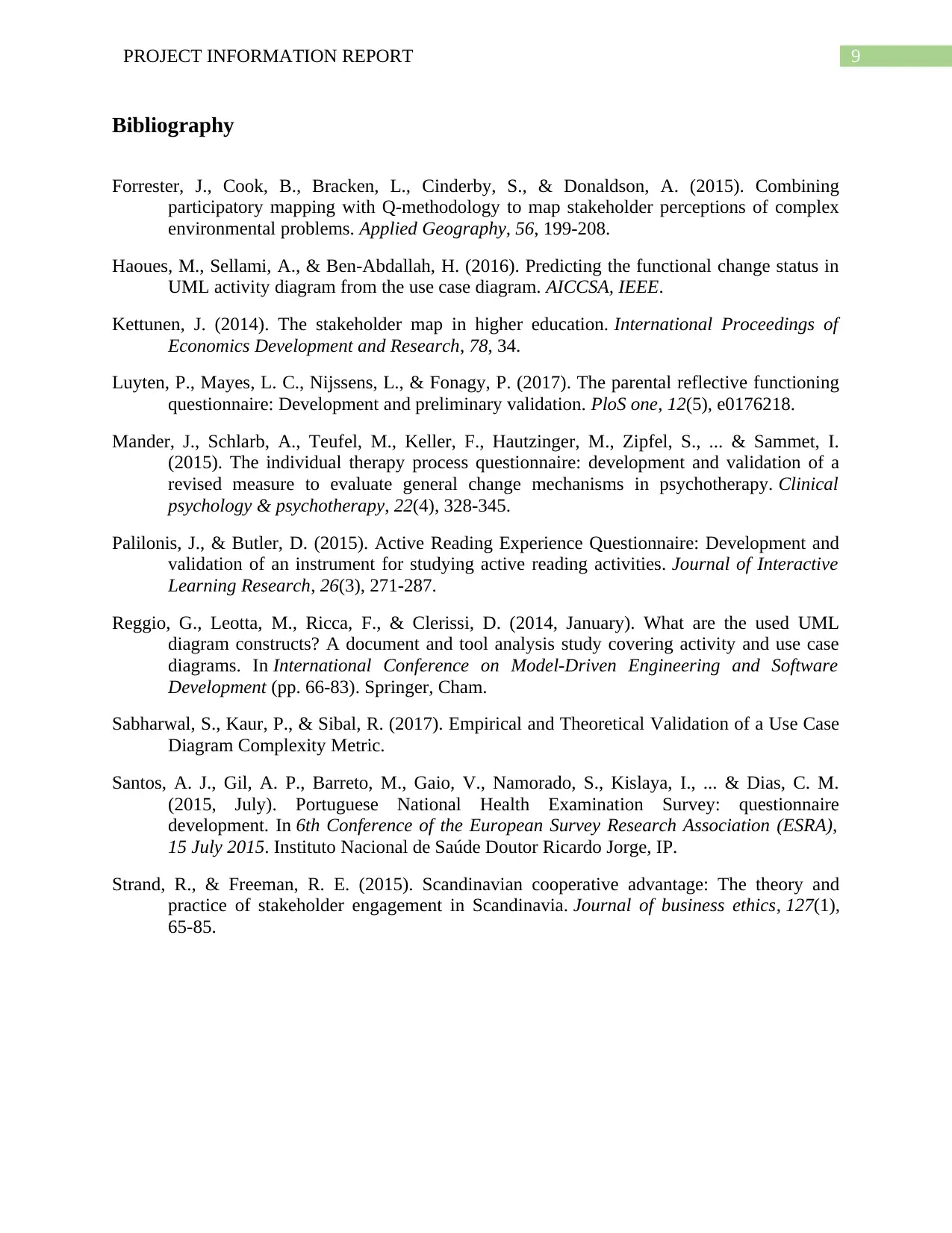
9PROJECT INFORMATION REPORT
Bibliography
Forrester, J., Cook, B., Bracken, L., Cinderby, S., & Donaldson, A. (2015). Combining
participatory mapping with Q-methodology to map stakeholder perceptions of complex
environmental problems. Applied Geography, 56, 199-208.
Haoues, M., Sellami, A., & Ben-Abdallah, H. (2016). Predicting the functional change status in
UML activity diagram from the use case diagram. AICCSA, IEEE.
Kettunen, J. (2014). The stakeholder map in higher education. International Proceedings of
Economics Development and Research, 78, 34.
Luyten, P., Mayes, L. C., Nijssens, L., & Fonagy, P. (2017). The parental reflective functioning
questionnaire: Development and preliminary validation. PloS one, 12(5), e0176218.
Mander, J., Schlarb, A., Teufel, M., Keller, F., Hautzinger, M., Zipfel, S., ... & Sammet, I.
(2015). The individual therapy process questionnaire: development and validation of a
revised measure to evaluate general change mechanisms in psychotherapy. Clinical
psychology & psychotherapy, 22(4), 328-345.
Palilonis, J., & Butler, D. (2015). Active Reading Experience Questionnaire: Development and
validation of an instrument for studying active reading activities. Journal of Interactive
Learning Research, 26(3), 271-287.
Reggio, G., Leotta, M., Ricca, F., & Clerissi, D. (2014, January). What are the used UML
diagram constructs? A document and tool analysis study covering activity and use case
diagrams. In International Conference on Model-Driven Engineering and Software
Development (pp. 66-83). Springer, Cham.
Sabharwal, S., Kaur, P., & Sibal, R. (2017). Empirical and Theoretical Validation of a Use Case
Diagram Complexity Metric.
Santos, A. J., Gil, A. P., Barreto, M., Gaio, V., Namorado, S., Kislaya, I., ... & Dias, C. M.
(2015, July). Portuguese National Health Examination Survey: questionnaire
development. In 6th Conference of the European Survey Research Association (ESRA),
15 July 2015. Instituto Nacional de Saúde Doutor Ricardo Jorge, IP.
Strand, R., & Freeman, R. E. (2015). Scandinavian cooperative advantage: The theory and
practice of stakeholder engagement in Scandinavia. Journal of business ethics, 127(1),
65-85.
Bibliography
Forrester, J., Cook, B., Bracken, L., Cinderby, S., & Donaldson, A. (2015). Combining
participatory mapping with Q-methodology to map stakeholder perceptions of complex
environmental problems. Applied Geography, 56, 199-208.
Haoues, M., Sellami, A., & Ben-Abdallah, H. (2016). Predicting the functional change status in
UML activity diagram from the use case diagram. AICCSA, IEEE.
Kettunen, J. (2014). The stakeholder map in higher education. International Proceedings of
Economics Development and Research, 78, 34.
Luyten, P., Mayes, L. C., Nijssens, L., & Fonagy, P. (2017). The parental reflective functioning
questionnaire: Development and preliminary validation. PloS one, 12(5), e0176218.
Mander, J., Schlarb, A., Teufel, M., Keller, F., Hautzinger, M., Zipfel, S., ... & Sammet, I.
(2015). The individual therapy process questionnaire: development and validation of a
revised measure to evaluate general change mechanisms in psychotherapy. Clinical
psychology & psychotherapy, 22(4), 328-345.
Palilonis, J., & Butler, D. (2015). Active Reading Experience Questionnaire: Development and
validation of an instrument for studying active reading activities. Journal of Interactive
Learning Research, 26(3), 271-287.
Reggio, G., Leotta, M., Ricca, F., & Clerissi, D. (2014, January). What are the used UML
diagram constructs? A document and tool analysis study covering activity and use case
diagrams. In International Conference on Model-Driven Engineering and Software
Development (pp. 66-83). Springer, Cham.
Sabharwal, S., Kaur, P., & Sibal, R. (2017). Empirical and Theoretical Validation of a Use Case
Diagram Complexity Metric.
Santos, A. J., Gil, A. P., Barreto, M., Gaio, V., Namorado, S., Kislaya, I., ... & Dias, C. M.
(2015, July). Portuguese National Health Examination Survey: questionnaire
development. In 6th Conference of the European Survey Research Association (ESRA),
15 July 2015. Instituto Nacional de Saúde Doutor Ricardo Jorge, IP.
Strand, R., & Freeman, R. E. (2015). Scandinavian cooperative advantage: The theory and
practice of stakeholder engagement in Scandinavia. Journal of business ethics, 127(1),
65-85.
1 out of 10
Related Documents
Your All-in-One AI-Powered Toolkit for Academic Success.
+13062052269
info@desklib.com
Available 24*7 on WhatsApp / Email
![[object Object]](/_next/static/media/star-bottom.7253800d.svg)
Unlock your academic potential
Copyright © 2020–2025 A2Z Services. All Rights Reserved. Developed and managed by ZUCOL.





